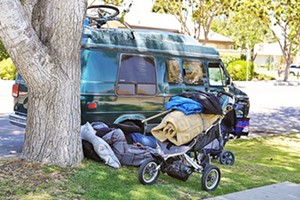Santa Barbara County's poverty rate is the third highest in the state, according to a new report from the nonpartisan, nonprofit think tank Public Policy Institute of California (PPIC).
The Central Coast county's 23 percent poverty rate trailed only Los Angeles (24.3) and Santa Cruz (23.8) counties.

"The picture of poverty is quite different than what you might expect based on the 1960s-era official poverty estimates," PPIC researcher Sarah Bohn told KQED News. "It tends to be higher on the coast, and some of that's driven by the high cost of living, but also by the fact that in some of those places families are working and less eligible for social safety net programs that boost their income."
The report issued in July found that more than 14 percent of Californians lacked enough resources, or around $24,000 for a family of four, to meet basic needs in 2016. PPIC explained this year's rate declined from 2015's of 15 percent, but was "well above the most recent low" of 12.4 percent in 2007. It should be noted that the official poverty line does not account for the state's housing costs or other critical family expenses and resources.
Nearly one in five Californians were found to not be living in poverty but still "lived fairly close to the poverty line" and at least two-fifths (more than 38 percent) of state residents were declared "poor" or "near poor" in 2016.
Moreover, the report's authors said poverty statewide is higher once key family needs and resources were factored in.
The California Poverty Measure (CPM), a joint research effort by PPIC and the Stanford Center on Poverty and Inequality, is a more comprehensive approach to gauging poverty in California. It accounts for the cost of living and a range of family needs and resources, including social safety net benefits.
According to the CPM, 19.4 percent of Californians (about 7.4 million) lacked enough resources to meet basic needs in 2016–about $31,000 per year for a family of four, nearly $7,000 higher than the official poverty line. Poverty was highest among children (21.3 percent) and lower among adults ages 18 to 64 (18.8 percent), and those age 65 and older (18.7 percent). The overall poverty rate went unchanged between 2015 and 2016, following two years of decreases.
"Latinos and less-educated Californians continue to have dramatically higher poverty rates" the report's authors added.
In 2016, 26.1 percent of Latinos lived in poverty, compared with 18.9 percent of African-Americans, 17.6 percent of Asian Americans, and 13.5 percent of whites. Though poverty among Latinos is down from 30.9 percent in 2011, Latinos remain disproportionately poor (making up 52.8 percent of poor Californians but 39.2 percent of all Californians). More education continues to be associated with strikingly lower poverty rates: The rate for adults ages 25 through 64 with a college degree was 8.4 percent, compared with 34.5 percent for those without a high school diploma.
This is not the first report out this month detailing the state of Santa Barbara County's poor. The county's 2017 Children's Scorecard found that 60,000 out 450,000 residents were living at or below the federal poverty level. Of that number, nearly 30 percent, or roughly 17,000, are children.
Barbara Finch, Children and Adult Network director with the Santa Barbara County Department of Social Services, recently told the Sun that most of the county's economic base was "driven by low-paying jobs in the agricultural and hospitality industries."
The conditions, coupled with high housing costs, are key factors in contributing to Santa Barbara County having the highest child poverty rate in the state, she said.









